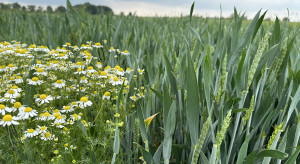Some of the winter cereal fields are exceptionally colorful this year. Cornflowers and poppies may be pleasing to the eye, but seeing them among the ears of grain does not bring joy to farmers. What is the reason for the increased occurrence of these weeds this year?
The unusual spring also affected weeds
The harvest is fast approaching, but in many fields of ripening winter cereals, attention is drawn to the large number of weeds. Although the occurrence of species such as cornflower, field poppy, field chamomile and grain broom is not uncommon in cereal cultivation, this year the problem seems to be particularly intensified. Our editorial staff observed it, among others: in Greater Poland. We asked Dr. about possible reasons for this state of affairs. Tomasz Sekutowski from the Department of Herbology and Agricultural Technology of IUNG. According to the herbologist, an important factor that influenced the heavy weed infestation included: cornflower, cornflower and field poppy this season is the unusual course of the growing season. We observed this, among others: in rapeseed, the flowering of which started several weeks earlier than in previous years. The weeds also started growing faster and thus “escaped” from growing before intervention was undertaken.
– Spring came quickly and brought a burst of high temperature, which, combined with soil moisture, caused the plants to develop very dynamically. Not only crops. After all, weeds are even more expansive and better adapted and quickly entered subsequent stages of development. As a result, finding the right moment for herbicide treatment was very difficult. Older plants, after the period of their greatest sensitivity to herbicides, cannot be destroyed – said Dr. Tomasz Sekutowski in an interview with farmer.pl.
Ineffective technology and the issue of resistance
Another possible cause of heavy weed infestation of cornflower and poppy fields is the lack of autumn herbicide treatment or its low effectiveness, e.g. due to an incorrect application date, too early or too late. The introduction of autumn herbicide protection into the technology of winter cereal management is very important in the fight against these weed species, because both germinate both in spring and autumn and are capable of wintering.
Dr. Sekutowski also draws attention to the probability of occurrence of resistant weed biotypes. Cornflower was one of the first dicotyledonous weeds to have a resistance problem. A few years later, the occurrence of resistant field poppy biotypes in Poland was confirmed. If in a given field there are cornflower or poppy biotypes resistant to sulfonylurea herbicides, spring treatment with active substances such as tribenuron or chlorsulfuron may not bring the expected herbicidal effect.
– Taking into account the issues of effectiveness of treatments and the problem of resistance, the most unreliable herbicide solution in spring is based technology on substances from the sulfonylurea group – said Dr. Tomasz Sekutowski.
Our interlocutor points out that despite the significant advantages of sulfonylureas, such as wide application possibilities, relatively low price or environmental safety thanks to small doses of the active substance, their one-sided, long-term use without rotation with substances with other mechanisms of action often ends in the development of weed resistance. .
– .


